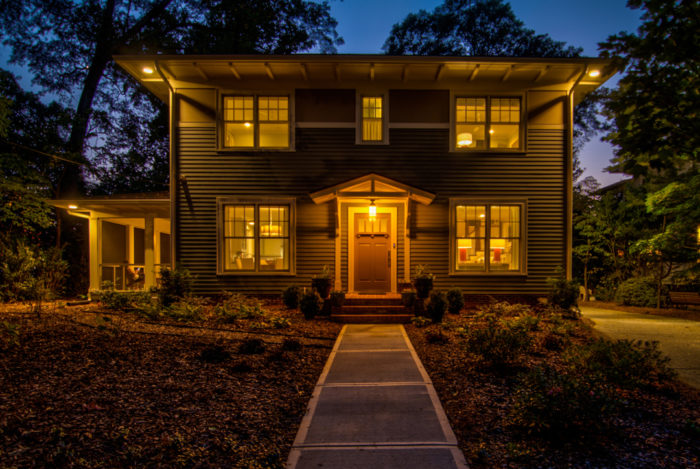
Image Credit: Image #1: Tim Ridley
Image Credit: Image #1: Tim Ridley Pretty much the center of our daily life is the kitchen counter.
Image Credit: Images #2 through #5: Carl Seville The carport serves double-duty as a bar and dance floor for outdoor parties. We spend a lot of time on the screened porch, often with the fans on. Recently installed, the Ultra-Aire dehumidifier is helping manage humidity without having to run the AC as often.
We have been living in our new house just over a year now, so it seems fitting to offer some thoughts and insight into how everything is working out. The answer, thankfully, is that all is good.
From a design and function standpoint, everything works great. We use every room in the house, so we didn’t overbuild. Energy use is low, as expected. The only issue we run into is controlling humidity, a common problem with low-load homes in mixed humid climates.
Shoulder seasons
The house is comfortable almost all the time, although we are still figuring out the best way to manage temperature and humidity in the shoulder seasons. The Atlanta area can have fairly large temperature and relative humidity swings on a daily basis.
Recently the temperature was in the 60s at night and almost 90 by midday. I prefer to open windows when the weather is moderate, and do so as often as I can; however, the process of turning HVAC equipment on or off and opening or closing windows twice or more per day sometimes falls by the wayside when I am busy, and makes me (just slightly) more tolerant of people who just keep their homes closed up and manage comfort exclusively with HVAC.
As summer approaches, I expect that we will rely on AC more than I would like. Earlier this spring we ran into a situation that I find common with high performance homes: the house was colder than the outside air, as it was holding its temperature so well. My wife was cold and was about to turn on the heat when I suggested she open a couple of windows. That did the trick, as it was in the mid 70s outside.
Last fall, we had our first issue with humidity. There were a few days in the mid 70s with high humidity. To keep the house comfortable, as well as avoid potential mold and mildew, I had to turn on the AC for a few days just to dehumidify.
As I noted in an earlier post, in retrospect, I would have used a venting dehumidifier instead of an ERV to help control indoor humidity when it is cool but humid. To better manage humidity, I recently installed an Ultra-Aire 98H dehumidifier in my mechanical room. I considered tying it into the existing ducts to and from the ERV, but the complexity of this installation wasn’t worth the effort. I ended up installing an intake and exhaust for the dehumidifier in my hallway, and it runs as needed to keep the RH in the 50% range, while the ERV provides the whole-house ventilation.
Having tried to use minisplits to dehumidify in the past, only to have them overcool the space, I understand that dehumidifiers need to take advantage of the reheat capacity of their compressors to control the outgoing air temperature. What I didn’t realize is that the exhaust air can be quite warm. Running the dehumidifier will end up adding slightly to the cooling load on the house, but so far it looks like the impact is minimal. Another option would be to install a split-system dehumidifier that doesn’t reheat the dehumidified air — but that’s not going to happen at this house.
Bored with my apps
I tried out several iPhone apps for various systems in the house, only to lose interest in them fairly quickly.
I had a CURB energy monitoring system installed; it provided real-time energy use for most circuits in the house. After a few weeks, it wasn’t providing me with enough useful information to continue watching it.
Similarly, I can access my thermostats and alarm systems through Honeywell apps, and while I have used them, I don’t find them useful enough to bother with them. Perhaps when I am out of town and want to make an adjustment to temperature or disarm the house so someone can enter, I will use them again.
I bought a Foobot to try out, and watched those reports on my phone for a while, only to lose interest in that as well.
Finally, we installed a Ring video doorbell with our low-voltage package. For some reason, the video was very slow to show up on my phone, so we didn’t find it that useful. Then it stopped working altogether, so I finally got rid of it.
I find that my simple indoor/outdoor temperature and humidity sensor gives me most of the information I need. I may be a bit of a Luddite, but I’m OK with that.
Energy use
I have been watching our electric use closely and tracking our Site Energy Use Intensity (EUI). Through the first year, we are averaging 920 kWh per month for this all-electric house, which includes two full-time home offices and charging one electric and one plug-in hybrid car.
Our EUI (kbtu/sf/yr) is 14.25 — well below the average for the southern U.S. of 41.5, and about 65% of the 2030 Challenge target. Without renewables on the house, this is about as efficient as a house with HVAC can be.
A “stealth” green home
I’ve come to think of this project as a “stealth” green home, primarily because it doesn’t have the touchstone “green” features people think about: solar panels, ground-source heat pumps, a heat-pump water heater or tankless water heaters, and maybe that key one, spray foam insulation.
It’s also a very traditional design which doesn’t seem to get as much attention as contemporary architecture these days. But I don’t care what people think about it. We are enjoying the house, the porch, and even the carport and driveway which, it ends up, is an awesome party space.
Weekly Newsletter
Get building science and energy efficiency advice, plus special offers, in your inbox.






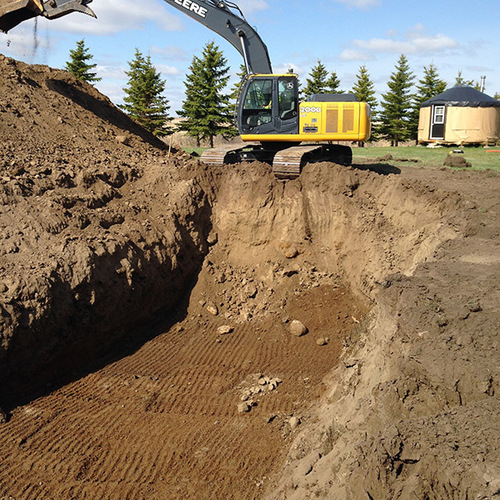
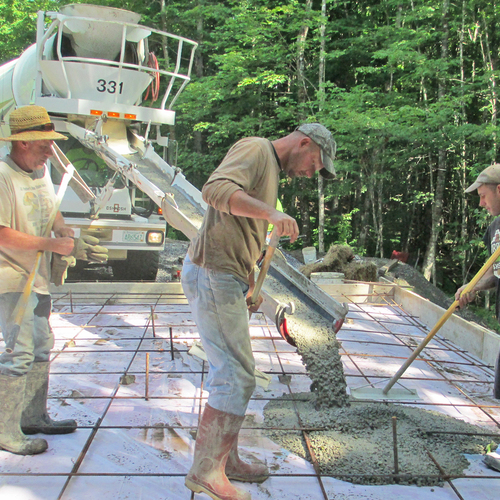
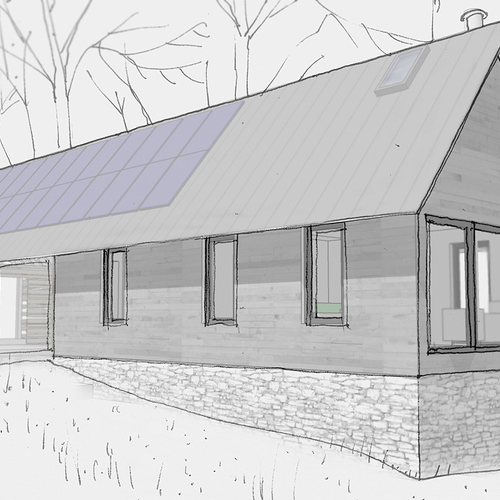
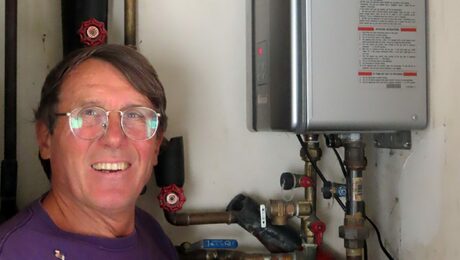

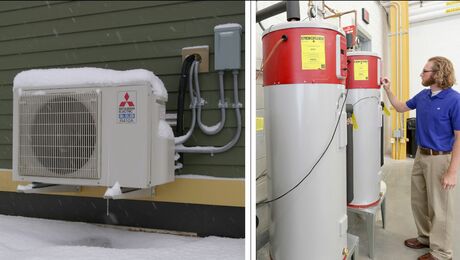
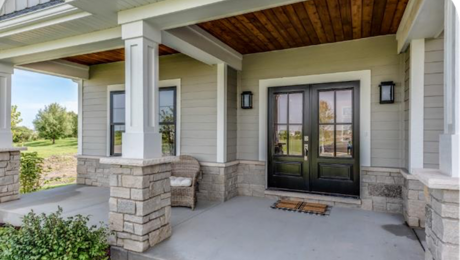
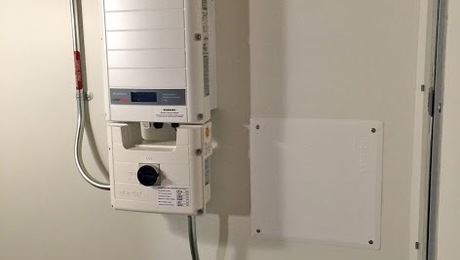

16 Comments
"Bored with the apps"
This is
"Bored with the apps"
This is why I'm surprised so many people bother with home energy monitoring systems. I just don't see most people looking at it beyond the first few months. It's also why I'm surprised there isn't a bigger market for used energy monitors.
Any idea how many miles the cars were driven, or how much of your power consumption was used for the cars?
Mileage and energy use
I haven't tracked our vehicle mileage or energy use, but we drive very little, so I expect that they haven't contributed to much of the energy use.
One interesting problem we are having is that the dehumidifier supply air is hotter that I initially reported. I am meeting with the manufacturer's rep this week to look at the situation and see if there is anything to do about it.
Dehumidifaction is a battle
Dehumidifaction is a battle I'm waging as well. I don't have enough cooling load in my basement to require AC, but I need to remove moisture. I'm hoping the new heat pump dryer will add enough heat to make it possible for the heat pump to run and not over cool, and the new front load washer & and discouraging my wife from hanging clothes to dry down there will cut down on moisture entering the basement enough that I wont need a separate system for dehumidication in the summer. I'll be monitoring the humidity levels carefully, but my next step will be insulating the slab to prevent condensation. I'm hoping to avoid adding another power using device if I can.
The house looks great, by the way. Thanks for the update.
Calum
If a Building Curmudgeon like Carl is bored with the apps, your average building owner will end up catatonic.
Dehumidifier Heat
Most residential dehumidifiers convert latent energy (water vapor) into sensible energy (heat) when dehumidifying. This can lead to comfort concerns (overheating) when applied in areas without adequate cooling capacity.
Carl - feel free to contact me if you desire additional support for your Ultra-Aire application as I work for the manufacturer.
Dehumidifier
Tim- An Ultra Aire rep was at the house yesterday. It doesn't look like the dehumidifier will work as I initially hoped due to the excess heat since it isn't dissipated into a whole house duct system. I may be able to use it on cool humid days, but it puts out too much heat to use that often.
house size
Can you tell me the sq ft of the home, How many bed rooms and baths?
Foundation type. Its double stud, right? Fiber glass or cellulose?
House details
Look at my previous posts - there are a total of 7 going through all the details of construction as well as plans you can view.
Carl
"I don’t care what people think about it. We are enjoying the house"
Well if you decide you do care a little bit - I think the whole thing turned out just great!
Response to HealthArchitect (Comment #7)
Health,
To gain access to all of Carl Seville's previous blogs -- the blogs that include the details about his house that you are curious about -- just click the big bold words at the top of this page that say "Green Building Curmudgeon." That will bring you to a new page listing all of Carl's previous blogs.
Indoor Air Quality question
It looks like your monitoring equipment is just temperature and relative humidity. Have you given any consideration to using monitors that measure many more aspects of indoor air quality like CO2, PM2.5, VOCs? "You can't manage what you don't measure." And opening up a window to change temps may be worse for RH and IAQ than you realize. Would also give you a much better idea if your ERV is doing you any good.
IAQ
David- I have a Foobot which provides a lot of the data you noted but as I said the readings don’t change much so I don’t track them closely. I recognize that opening windows may add some moisture load to the house but I avoid it when RH outside is high and am willing to sacrifice a little energy to avoide living in a sealed chamber 24/7. Today it was below 70 degrees and less than 60% rh outside so we opened the house up. Will close it later as temp rises.
Dehumidifier Heat
Carl - Operating a typical dehumidifier can produce plenty of sensible heat. Roughly 1,000Btu for each pound (pint) of water vapor removed from the air and converted to liquid water and about 500Btu for the electrical energy consumed to do that work although this depends on the efficiency of the dehumidifier.
If you can direct the warm dehumidifier supply air towards your min-split it should transfer the "extra" dehumidifier heat outside. You might need to look at interlocking the dehumidifier and your AC.
Other options include our SD-12 split dehumidifier which rejects the latent heat energy outdoors, but it is a more involved installation (similar to mini-split) than the 98H you have now.
You may also use the DEH3000 control to lock-out the 98H if the room temperature exceeds your desired maximum temperature setting. This will prevent the 98H from lowering the humidity in your house when it is locked out, but prevents it from overheating the area where the DEH3000 control is installed.
Strange that CURB didn't work for you. CURB isn't available in India so we use an alternative called Ohm Assistant. This works great and helps us with monitoring our power consumption at home. Check them out if you're interested: https://ohmassistant.com/
Wow, your house looks amazing! I dream of having a country house. Yes, I have heard that such houses have a problem with humidity. We'll soon take out a loan and start looking for a home. We are a big family so a two-story house will be the best option. We dream of moving from our New York apartment to a big house in Los Angeles. Can anyone share their experience with moving over such long distances? I've been looking into the services of moving companies. It's a great option because I have no idea how you can move all your stuff by yourself. I visited this site https://sekamoving.com/moving/long-distance-movers/movers-from-nyc-to-la/ and got advice from top movers about moving and its difficulties.
That sounds like a big move! Make sure to stop at a diner along the way for some
Egg and spam
Egg, bacon and spam
Egg, bacon, sausage and spam
Spam, bacon, sausage and spam
Spam, egg, spam, spam, bacon and spam
Spam, sausage, spam, spam, spam, bacon, spam tomato and spam
Spam, spam, spam, egg and spam
or, if you prefer, there's always the Lobster Thermidor aux crevettes with a mornay sauce, served in a provencale manner with shallots and aubergines garnished with truffle pate, brandy and a fried egg on top and spam.
Log in or create an account to post a comment.
Sign up Log in